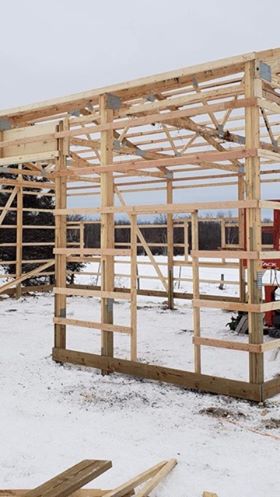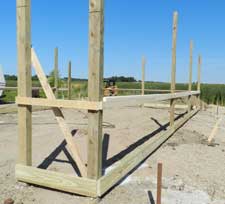Reader DARRELL in LUCEVILLE asked this question and included photo below.

While this photo is not of a Hansen Pole Building, I can comment upon it. Featured in this building photo are glulaminated columns – they are a great product, high strength to weight ratio, straight, highly resistant to warp and twist. They are strong because they are most generally manufactured from high strength materials, most three ply 2×6 columns have a Fb rating (Fiberstress in bending) of roughly 1900 psi. Your local lumber dealer or big box store will gladly sell you a 2×6 #2 with a Fb rating of anywhere from 1000 to 1170 (depending upon lumber species, with SYP lowest and Douglas Fir highest), so a glulam’s three members start off being about equal to five every day individual 2×6.
What about strength comparisons to solid timbers?
To determine bending strength of a member, multiply Fb X Sm (Section Modulus). A three ply 2×6 glulam would be 1900 X 19.86 = 37,738 in-lb. A 6×6 #2 SYP would be 850 X 27.73 = 23,570 in-lb. A 6×6 #2 Hem-Fir (treated species of choice in Western U.S.) has a base Fb of 575 with a reduction for incising of 20% (X .80). 575 X .80 X 27.73 = 12,755 in-lb.
Clearly, when picking for strength, glulam columns are going to be a better choice.
When it comes to practicality on a jobsite, would you prefer to carry a 20 foot long glulam weighing roughly 100 pounds, or hefting a same length 6×6 tipping your scale at 180 to 300 pounds? Not much to think about there!
Glulams columns are more prevalent in northern states due to locations where they are manufactured – primarily Pennsylvania, Ohio, Wisconsin and South Dakota. We do offer them as an option on any Hansen Pole Building. Give a call to a Building Designer today at 1(866)200-9657 for your post frame building design solution.







